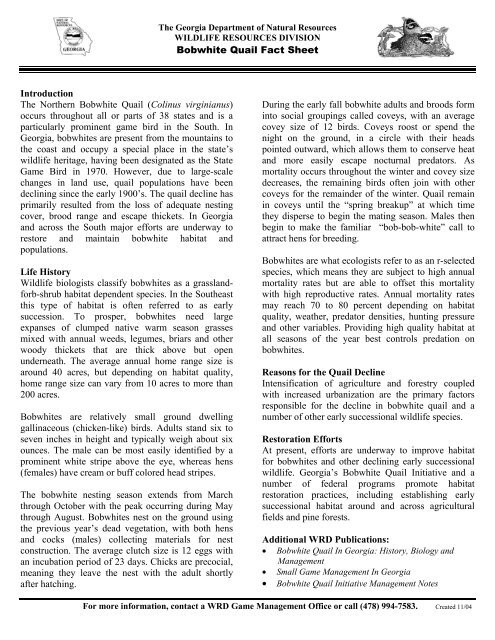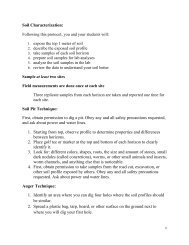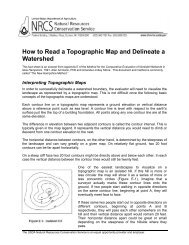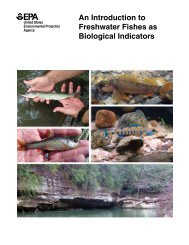Bobwhite Quail Fact Sheet - North American Envirothon
Bobwhite Quail Fact Sheet - North American Envirothon
Bobwhite Quail Fact Sheet - North American Envirothon
Create successful ePaper yourself
Turn your PDF publications into a flip-book with our unique Google optimized e-Paper software.
The Georgia Department of Natural ResourcesWILDLIFE RESOURCES DIVISION<strong>Bobwhite</strong> <strong>Quail</strong> <strong>Fact</strong> <strong>Sheet</strong>IntroductionThe <strong>North</strong>ern <strong>Bobwhite</strong> <strong>Quail</strong> (Colinus virginianus)occurs throughout all or parts of 38 states and is aparticularly prominent game bird in the South. InGeorgia, bobwhites are present from the mountains tothe coast and occupy a special place in the state’swildlife heritage, having been designated as the StateGame Bird in 1970. However, due to large-scalechanges in land use, quail populations have beendeclining since the early 1900’s. The quail decline hasprimarily resulted from the loss of adequate nestingcover, brood range and escape thickets. In Georgiaand across the South major efforts are underway torestore and maintain bobwhite habitat andpopulations.Life HistoryWildlife biologists classify bobwhites as a grasslandforb-shrubhabitat dependent species. In the Southeastthis type of habitat is often referred to as earlysuccession. To prosper, bobwhites need largeexpanses of clumped native warm season grassesmixed with annual weeds, legumes, briars and otherwoody thickets that are thick above but openunderneath. The average annual home range size isaround 40 acres, but depending on habitat quality,home range size can vary from 10 acres to more than200 acres.<strong>Bobwhite</strong>s are relatively small ground dwellinggallinaceous (chicken-like) birds. Adults stand six toseven inches in height and typically weigh about sixounces. The male can be most easily identified by aprominent white stripe above the eye, whereas hens(females) have cream or buff colored head stripes.The bobwhite nesting season extends from Marchthrough October with the peak occurring during Maythrough August. <strong>Bobwhite</strong>s nest on the ground usingthe previous year’s dead vegetation, with both hensand cocks (males) collecting materials for nestconstruction. The average clutch size is 12 eggs withan incubation period of 23 days. Chicks are precocial,meaning they leave the nest with the adult shortlyafter hatching.During the early fall bobwhite adults and broods forminto social groupings called coveys, with an averagecovey size of 12 birds. Coveys roost or spend thenight on the ground, in a circle with their headspointed outward, which allows them to conserve heatand more easily escape nocturnal predators. Asmortality occurs throughout the winter and covey sizedecreases, the remaining birds often join with othercoveys for the remainder of the winter. <strong>Quail</strong> remainin coveys until the “spring breakup” at which timethey disperse to begin the mating season. Males thenbegin to make the familiar “bob-bob-white” call toattract hens for breeding.<strong>Bobwhite</strong>s are what ecologists refer to as an r-selectedspecies, which means they are subject to high annualmortality rates but are able to offset this mortalitywith high reproductive rates. Annual mortality ratesmay reach 70 to 80 percent depending on habitatquality, weather, predator densities, hunting pressureand other variables. Providing high quality habitat atall seasons of the year best controls predation onbobwhites.Reasons for the <strong>Quail</strong> DeclineIntensification of agriculture and forestry coupledwith increased urbanization are the primary factorsresponsible for the decline in bobwhite quail and anumber of other early successional wildlife species.Restoration EffortsAt present, efforts are underway to improve habitatfor bobwhites and other declining early successionalwildlife. Georgia’s <strong>Bobwhite</strong> <strong>Quail</strong> Initiative and anumber of federal programs promote habitatrestoration practices, including establishing earlysuccessional habitat around and across agriculturalfields and pine forests.Additional WRD Publications:• <strong>Bobwhite</strong> <strong>Quail</strong> In Georgia: History, Biology andManagement• Small Game Management In Georgia• <strong>Bobwhite</strong> <strong>Quail</strong> Initiative Management NotesFor more information, contact a WRD Game Management Office or call (478) 994-7583. Created 11/04
The Georgia Department of Natural ResourcesWildlife Resources DivisionWOOD DUCK FACT SHEETThe wood duck (Aix sponsa) is the most common duck inGeorgia. It is the only species that traditionally nests here, and itis one of only a few species of waterfowl that nests in a cavityrather than on the ground. Considered by many to be the mostbeautiful of all <strong>North</strong> <strong>American</strong> waterfowl, the wood duck iscertain to enhance any location in which it appears.BIOLOGYAbout half the size of a mallard, the wood duck (woodie) is atype of dabbling duck, meaning it forages on the water’s surfacefor food as opposed to diving for food on the bottom. Duringthe fall and winter, woodies need foods such as acorns that arehigh in fat to carry them through the harsher months and toprepare them for breeding and laying eggs. Springrequirements shift towards higher protein foods like insects topromote growth. Wood ducks begin courtship rituals severalmonths before the nesting season, which usually begins inFebruary and lasts through June. Pair bonds normally lastthrough the brood-rearing season. A hen will lay one egg eachday until she reaches an average clutch size of 10-15 eggs. Ifsomething happens to the nest, hens will renest in an effort tohatch a successful brood. Incubation begins after the last egg islaid, and hatching occurs about 30 days later. About 24 hoursafter hatching, the hen begins calling the chicks out of the nestto explore their new world on water. By the time the chicks are5 weeks of age, they are quite independent from the hen. Asmaturity progresses, ducks will begin the courtship ritual andbreed at one year of age.HABITATWood ducks are closely associated with forested wetlandhabitats throughout <strong>North</strong> America. Woodies seldom venturefar from woodlands and associated water areas. Theirdistribution is essentially confined to riparian corridors and otherareas of lowland forest interspersed with freshwater ponds,lakes, marshes, and swamps. Beaver ponds form some of thefinest wood duck habitat around. Flooded emergent vegetationthat protrudes above the surface of the water provides goodbrood-rearing cover. Buttonbush, alder, or other shrubs thatgrow out of the water provide protection from aerial predators.Other emergent vegetation such as sedges and rushes alsoprovide places for young ducklings to hide.NEST BOX MANAGEMENTErecting wood duck nest boxes can help raise local populationsin your area. For maximum benefit, proper placement of woodduck boxes is extremely important. Farm ponds may not be agood place for duck boxes as most have steep sides, deep edgesand no emergent vegetation. Without emergent vegetation, theducklings have no place to hide, and rapidly fall prey to variouspredators, such as snapping turtles and largemouth bass.NEST BOX CONSTRUCTIONThere are several different designs for wood duck nest boxes,however all boxes should be between 20-27” in height and 10-12” square. The preferred lumber for building wood duck nestboxes is rough-cut 1” thick cypress, however cedar or yellowpine is acceptable. DO NOT use treated lumber. The boxshould be held together with 1 ½” zinc coated or galvanizedwood screws. To allow ducklings to climb up and escape, ½”wire mesh should be mounted to the inside of the box under thefront hole. See the reverse side for instructions on building awood duck box and predator guard.GUIDELINES FOR MOUNTING NEST BOXES1. Boxes should be placed so there is a 40’ flight line infront of the box that is free from obstructions such astree limbs or bushes.2. Wooden 4”x4”or 2” diameter metal posts can be usedto mount boxes. Post should be 10-12’ long. No boxshould be mounted without a predator guard aroundthe post.3. Position the box as nearly vertical as possible, with avery slight tilt forward. The tilt will enable ducklingsto climb out more easily.4. Boxes should be placed one per acre of suitable broodrearinghabitat.5. Boxes should be placed so that the bottom of the box isat least 4’ above the high water mark.6. Do not place more than one box per post, as this mayincrease the possibility of “dump nesting.”7. When attaching the box to the post, use 3-5” lag boltsinstead of nails. Bolts make it easier to remove boxesin the future for replacement or repair as necessary.8. Wasps can be kept out of the boxes using a small pieceof no-pest strip stapled or tacked inside the box.9. Once erected, boxes should be lined with about 4” ofwood shavings, not sawdust. Cedar shavings areacceptable to use.10. Boxes should be checked and cleaned annually duringDecember or January, prior to the nesting season.For more information, contact a WRD Game Management Office or call (770) 918-6416. Revised 03/02
The Georgia Department of Natural ResourcesWildlife Resources DivisionEASTERN WILD TURKEY FACT SHEETHISTORYThe eastern wild turkey, Meleagris gallopavo, is the largestgallinaceous bird in <strong>North</strong> America. However, due to unregulatedhunting and habitat loss caused by forest clearing, wild turkeyswere almost extirpated from Georgia by the early 1900s. Asforests regenerated after the great depression, available wildturkey habitat increased. Implementation of conservation laws,advances in wildlife science and funding for wildlife restorationprograms all played a role in the come back of the eastern wildturkey.In 1973, Georgia’s estimated wild turkey population was17,000 birds but that year marked the start of the Georgia’s wildturkey restoration program. Since that time with the help of itsconservation partners, Wildlife Resources Division associates andvolunteers have trapped and relocated more than 4,800 wildturkeys to over 300 suitable sites across the state. The wild turkeyrestoration program ended in 1996 and since then, with adequateprotection and biologically sound hunting seasons, wild turkeypopulations in Georgia have increased to over 400,000 birds.PHYSICAL CHARACTERISTICS & REPRODUCTIONWild turkeys breed in the spring. After spending the winterin bachelor flocks, adult males, known as toms or gobblers, willdisband and begin to strut and gobble in an effort to attract hensfor mating. Adult males weigh between 17-21 pounds and haveblack-tipped breast feathers. The tom’s featherless head is whitecrownedwith varying amounts of blue and red. Male gobblershave beards that grow to about 3-5 inches per year. Males alsohave spurs on their heals, which can be over 2 inches long.Gobbling usually begins in March but can start in late-February or early April. A gobbler will mate with as many hensas possible and hens will mate with a gobbler more than once.Juvenile males, known as jakes, will also strut and gobble but areless successful at courting hens than older males. Jakes can bedistinguished from the adult male gobblers by the 4-6 centralfeathers on the jakes tail fan. These feathers will be longer thanthe other tail feathers forming an uneven edge to the tail. Jakesalso have smaller beards and spurs than adult gobblers.Most hens will breed and nest during their first spring. Hensare smaller than toms and weigh 8-11 pounds and have bufftippedbreast feathers giving them a brown or tan coloration. Thehead of the female is a dull gray-blue with feathers extending upthe back of the head. Although some hens can have beards mosthens do not have beards or spurs. Hens are capable of retainingviable sperm for about two months. Therefore, all the eggs forand entire clutch and renesting attempt can be fertilized from onemating episode.As the breeding season comes to an end, usually in April,hens nest in shallow depressions formed by scratching, squattingand laying eggs. Nests are often at the base of trees or againstfallen logs and are usually located near open areas. The nest isusually in dense enough vegetation to conceal the nest but allowthe hen to view her surroundings from ground level.Hens lay about one egg each day until the clutch, usually10-12 eggs, is complete. Hens incubate the nest for about 28days. After the poults hatch, they are ready to leave the nest inabout 12-24 hours. The poults can walk and feed on insects whenthey are a day old. The hen will brood the chicks when they arecold or hot. The poults can take short flights when they are 8-days old and when they are about 2 weeks old; they begin to roostin trees at night with the hen. Most broods stay together 4-5months and female poults may remain with the hen until the startof the next breeding season.DIETAlmost 80% of the poult’s diet in their first week of life isinsects such as grasshoppers, beetles, and true bugs. Insects arehigh in protein, which is important for the fast-growing poults. Asthe poults age, they include more plant material in their diet.Quality wild turkey habitat is important to the poult’s survival andconsists of weedy or grassy openings with knee-high vegetationand scattered trees or shrubs that cover approximately 50 percentof the ground.Plant material makes up most of the adult turkey’s diet.Adult turkeys eat a variety of nuts, berries, plants and insects.Examples of foods eaten by wild turkeys include: acorns,beechnuts, pecans, pine seeds, blackberries, wild grapes,blueberries, poison ivy berries, grass seeds, snails andgrasshoppers. Turkeys have also been known to eat small frogs,lizards and crayfish.HABITATWild turkeys need a mixture of forests and open areas tomeet their seasonal habitat requirements. Quality turkey habitat iscomprised of mature woodlands with open understories and welldevelopedmidstories, interspersed with grassy or weedyopenings.By early autumn pecking orders have been establishedwithin flocks and by late autumn, males and females have usuallyformed separate flocks and moved into their winter range. Thisshift is normally from field to forest habitat. As the growingseason ends, seeds and insects in the fields become less availableand hard & soft mast in the forest become preferred foods.Throughout the winter turkeys congregate into large flocks inareas that offer shelter from the elements and reliable foodsources. The following spring as the weather warms and the daysbecome longer the flocks break up and the breeding cycle startsagain.For more information, contact a WRD Game Management Section Office or call (770) 918-6416.
The Georgia Department of Natural ResourcesWildlife Resources Division (WRD)WHITE-TAILED DEER FACT SHEETIntroductionWhite-tailed deer (Odocoileus virginianus) once were nearlyeliminated in the state of Georgia, but through diligent wildlifemanagement efforts deer were successfully restored throughoutthe state. In fact, the current deer population exceeds 1.2 million.Deer are a valuable natural, recreational, and economic resource inGeorgia, bringing in more than $800 million per year in huntinglicense fees, sporting equipment sales, food and land leases.However, deer densities in some localized areas have the potentialto inflict significant damage to forestry, agricultural orhorticultural crops, home gardens, and shrubbery. But becausedeer are important both biologically and economically,management of their numbers requires consideration onnumerous levels.BiologyScientific studies of white-tailed deer in recent years haveprovided much knowledge of deer biology and behavior. Forexample, adult deer in Georgia range from 70 to 250 pounds withbucks (males) typically weighing more than does (females).Breeding season (called “the rut”) extends from October toJanuary and peaks in November. Gestation period is 200 days.Newborns, called fawns, are spotted and range from 4-8 lbs.Most are born between May and August with a peak in June. Forthe first month or so, does spend very little time with fawns,hiding them for hours at a time and returning to nurse them only 4or 5 times per day. This tactic helps keep scent levels very low sopredators are not attracted to newborns. Young deer beginforaging on plants within a month and are completely weaned inthree months.Deer home range sizes in Georgia vary from 150 acres to morethan 1,200 acres with does having smaller ranges than bucks.Smaller ranges also are found in higher deer populations in betterdeer habitat such as that found in the Georgia Piedmont andUpper Coastal Plain. Deer are most active around dawn and dusk.This is called a crepuscular activity pattern.Although most hunters think in terms of bucks, it is the doesegment of the herd that determines most of the differences foundin deer populations. For example, depending on the food supplyand the total deer population, does can produce twins, singles, ornot bear any fawns at all. If births exceed the total death rate fromhunting and other causes in any particular year, then thepopulation increases. Eventually, the population reaches a sizewhere it exceeds the available food supply (“carrying capacity” ofthe land) resulting in lower birth rates, poor antler development,lower body weights and eventually a lower population as theremaining food supply is permanently damaged.The deer herd is the result of a complex interaction of food supply,population size, births, deaths, movements, weather, and pasthistory. Hunting is the one tried and true method for managingdeer populations in order to reach desired deer herd objectives.Deer AntlersAntler development is important to many hunters and deerobservers. Buck antler development is controlled by age, nutrition,and genetics. However, in Georgia genetics do not appear to bean important factor. For most deer in this state, age is the singlemost limiting factor for antler development, followed by nutrition.Under heavy hunting pressure, bucks simply do not live longenough to produce large antlers. In parts of the Lower CoastalPlain and Mountains, bucks live much longer but nutrition levelsoften are poor which limits antler development. Likewise, poornutrition also occurs in the Piedmont when deer herds get so largethat their food supply is reduced in quality or quantity resulting inpoor antler growth.Food HabitsDeer are the only native animals that routinely browse plants 4 to5 feet above the ground. They eat about five pounds per day (dryweight) of hundreds of species of both native and non-nativeplants but have definite preferences for certain plants, fruits andnuts. Some of their favorites include Japanese honeysuckle,acorns, grapes, apples, persimmons, greenbrier, blackberry,maple, blackgum, grasses, corn, clover, summer weeds, andsumac.HabitatDeer are known as generalists because of their ability to thrive in awide variety of habitats including forests, woodlots, suburbs, golfcourses, extensive agriculture, swamps and coastal marshes. Highdeer numbers are a serious concern because they can destroy theirown habitat and that of dozens of other species, even causingextirpation of plant species. The best deer habitat contains mixedages of pine and hardwood forests interspersed with openings andagriculture. This provides the optimum combination of food,cover, and water that are the essential components of any habitat.Additional WRD Publications• Deer Herd Management for Georgia Hunters• Controlling Deer Damage in GeorgiaFor more information, contact a WRD Game Management Office or call (770) 918-6416. Revised 04/04






